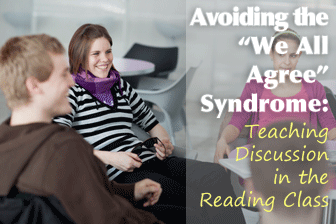What Do I Say to Her Now? Teaching How to Respond to a Peer


At the end of the story, when her husband unexpectedly returned home, the news of his death a mistake, the woman dies—“of a joy that kills.” In discussing the story, I went over some of its themes and the common perspectives on those themes—that women in the story’s time, the mid-nineteenth century, were often oppressed by marriage, and that widowhood in fact could give a woman a certain amount of freedom and status she wouldn’t have enjoyed as a married woman.
After class, a young student came up to me and expressed her shock that a woman would feel joy on her husband’s death. And I agreed with her that it was pretty shocking, and the author may have intended that, and so forth. We talked some more about the story and came to some agreement that the character was probably feeling mixed emotions on her husband’s “death.” As she was leaving, the young woman said “So I can see this differently from you?” The question surprised me, and I responded that not only could she do that, she should, that it was encouraged for students to form their own opinions on course material. The incident brought home for me that often college students, especially young ones, really aren’t used to the process of evaluating information, drawing conclusions, and forming some opinion on that information because they have often come from school systems where they are just given information and are expected to accept it without evaluation. If this is true of students raised in the United States, a culture that promotes freedom of thought and expression, it would be even more true for those not from such a culture.

Often instructors will avoid teaching this process of developing one’s own stance on material through critical discussion because it is a difficult process, time consuming, and somewhat messy. A class engaged in heated exchange of ideas is not always an orderly class. In addition, it does take time and effort, as students do not develop critical thinking and speaking skills overnight and may well be resistant to a process they are not used to. However, teaching this process is worth the time and effort invested as it pays off large dividends in the quality of student discussion, which almost inevitably carry over to writing skills as well, and essays become more thoughtful and developed.
On the other hand, students who have not learned the process of an academic exchange have discussions that are quiet, easy, short—and boring. Everyone agrees with each other, answers the discussion questions, and then pronounces “We’re done!” as they, too, would just as soon avoid the difficulty of a more critical examination of the issues.
Following are steps to improve the quality of your class discussions to avoid the “We-all-agree-and-we’re-done” phenomenon.

Sometimes students fail to go much beyond discussion of the facts of a story—“The family lived in New Orleans a long time ago”--because they have a basic confusion of the difference between a fact and a opinion. Address this confusion by modeling the difference between fact and opinion with examples such as “The story is set in New Orleans” and “New Orleans is an appropriate setting because of its long and colorful history.”
Then have students label a series of such statements as either “fact” or “opinion” and go over as a class. You may follow this up by having students take “fact” statements—“At the story’s writing, women did not yet have the vote in the U.S.”—and turning them into opinions.
Students often have flat, short, and boring discussions because they don’t know the rules of an academic discussion. Often students are good at agreeing with each other but don’t know how to politely disagree or even that this is possible. A good discussion, however, almost demands disagreement—a discussion in which everyone agrees is not really an academic discussion but merely a conversation. Learning this, that discussion requires disagreement, is a major hurdle.
Therefore, learning some basic language like “Well, I understand your point, but I disagree, and here’s why” is important. Finally, students need to learn they must contribute to a discussion and advance it; they can’t just say “I agree with Jorge,” and be done. They must elaborate on why they agree because the other students--having been trained to--will ask them why. Finally, the teacher will not give them points for just agreeing.
Sometimes, of course, the teacher is at fault for boring discussions (see ‘How to Lead Discussions: No Need to Speak Like Obama’). If students are given “discussion questions” such as “Who are the main characters?” and “Where is the story set?” then of course students will have discussions that stay on a superficial, factual level. However, a question like “How does the setting contribute to, or fail to contribute to, the story?” will spark more disagreement and discussion.
If, after the above steps, the students continue to insist “We all agree” during discussions, the teacher can himself take the opposing view: “I think the main character’s reaction to her husband’s death is perfectly understandable,” forcing the students to argue that stance with the teacher because they can’t claim, if they are opposing views, that they agree with each other and also agree with the teacher; they’re forced into defending their view.
After students have had some practice with “real” discussions that go beyond the surface, have them start developing their own discussion points. After doing a reading, students can work together to come up with points they’d like to go over in discussion. Then for the next session, they should come prepared to discuss those points.
With some careful training, students can hold engaging discussions that will prepare them to write better and succeed in their college lives.